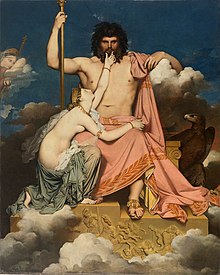
Back آلهة السماء Arabic Déu del cel Catalan Deidad celestial Spanish ایزد آسمان Persian 天空神 Japanese 천공신 Korean Andriamanitry ny lanitra Malagasy Hemelgod Dutch Höggud Swedish Gökyüzü tanrısı Turkish
This article has multiple issues. Please help improve it or discuss these issues on the talk page. (Learn how and when to remove these messages)
|

The sky often has important religious significance. Many religions, both polytheistic and monotheistic, have deities associated with the sky.
The daytime sky deities are typically distinct from the nighttime ones. Stith Thompson's Motif-Index of Folk-Literature reflects this by separating the category of "Sky-god" (A210) from that of "Star-god" (A250). In mythology, nighttime gods are usually known as night deities and gods of stars simply as star gods. Both of these categories are included here since they relate to the sky. Luminary deities are included as well since the sun and moon are located in the sky. Some religions may also have a deity or personification of the day, distinct from the god of the day lit sky, to complement the deity or personification of the night.
Daytime gods and nighttime gods are frequently deities of an "upper world" or "celestial world" opposed to the earth and a "netherworld" (gods of the underworld are sometimes called "chthonic" deities).[1] Within Greek mythology, Uranus was the primordial sky god, who was ultimately succeeded by Zeus, who ruled the celestial realm atop Mount Olympus. In contrast to the celestial Olympians was the chthonic deity Hades, who ruled the underworld, and Poseidon, who ruled the sea.[2]
Any masculine sky god is often also king of the gods, taking the position of patriarch within a pantheon. Such king gods are collectively categorized as "sky father" deities, with a polarity between sky and earth often being expressed by pairing a "sky father" god with an "earth mother" goddess (pairings of a sky mother with an earth father are less frequent). A main sky goddess is often the queen of the gods and may be an air/sky goddess in her own right, though she usually has other functions as well with "sky" not being her main. In antiquity, several sky goddesses in ancient Egypt, Mesopotamia, and the Near East were called Queen of Heaven.
Gods may rule the sky as a pair (for example, ancient Semitic supreme god El and the fertility goddess Asherah whom he was most likely paired with).[3] The following is a list of sky deities in various polytheistic traditions arranged mostly by language family, which is typically a better indicator of relatedness than geography.
- ^ Kearns, Emily (2011-12-15), "Chthonic Deities", The Homer Encyclopedia, Oxford, UK: Blackwell Publishing Ltd, doi:10.1002/9781444350302.wbhe0296, ISBN 978-1-4051-7768-9,
But the word "chthonic" is usually taken to refer principally to what is under the earth.
- ^ Buckler, John (2015-12-22), "Helicon", Oxford Research Encyclopedia of Classics, Oxford University Press, doi:10.1093/acrefore/9780199381135.013.2979, ISBN 978-0-19-938113-5
- ^ El was identified with the obscure deity Yahweh in early Hebrew religion, ultimately giving rise to Hebrew monotheism by the 7th century BCE; according to the Hebrew Bible it was 7th-century Judean king Josiah who removed the statue of Asherah from the temple of Yahweh in Jerusalem. See also The Hebrew Goddess.